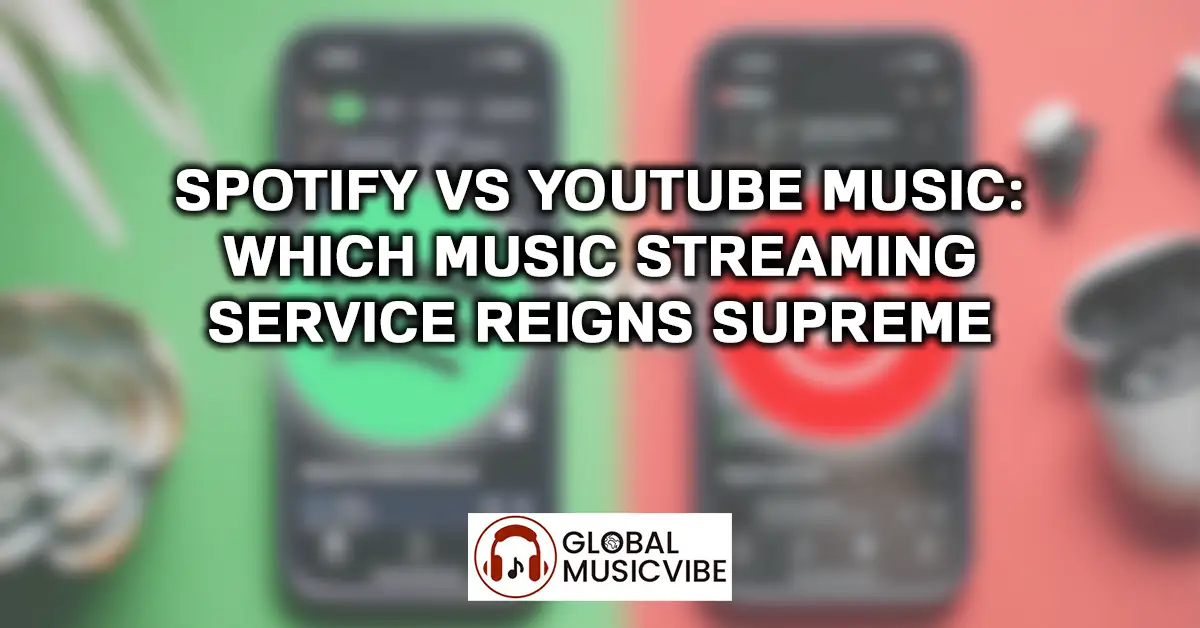The music streaming wars continue to intensify, with Spotify vs YouTube Music emerging as one of the most hotly debated comparisons among music enthusiasts. Both platforms offer extensive music libraries, personalized recommendations, and premium features, but which one truly delivers the best value for your money? This comprehensive comparison will help you make an informed decision between these two streaming giants.
Music Library and Content Diversity
When comparing music catalogs, both platforms boast impressive collections exceeding 100 million tracks. However, YouTube Music has an edge in terms of content diversity. It not only offers official songs and albums but also includes live performances, remixes, covers, and even user-generated content, thanks to its integration with YouTube. This means you can access rare bootlegs, live concert recordings, fan-made remixes, and covers that simply aren’t available on Spotify.
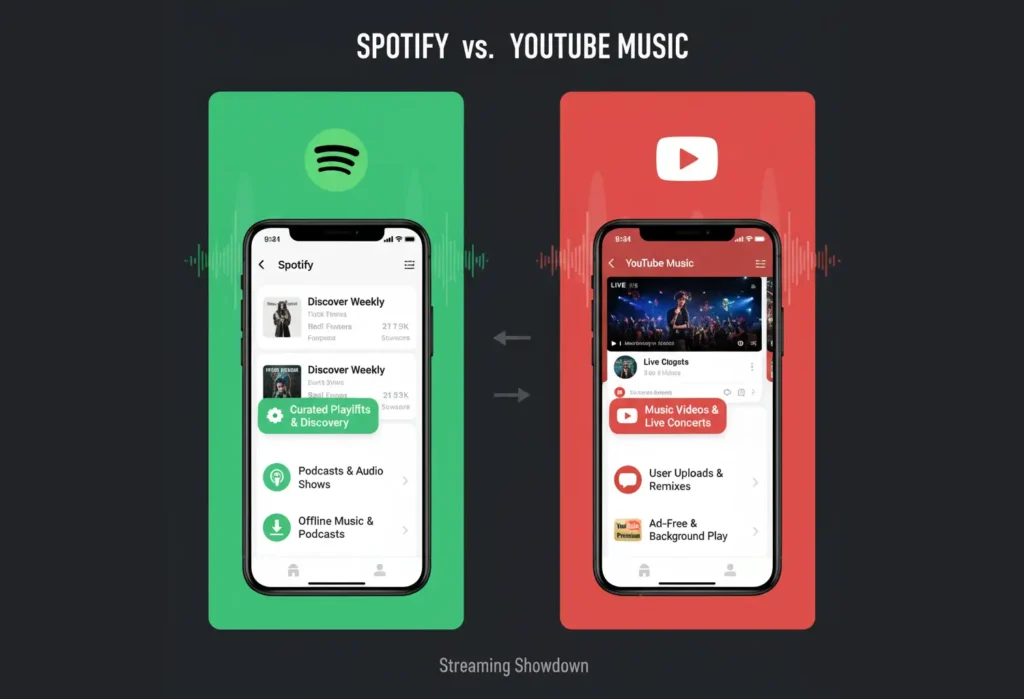
YouTube Music has much more music on offer, with tons of rare and old obscure music compared to Spotify. The platform’s connection to YouTube’s vast video library gives it access to content that traditional music streaming services can’t match, including artist interviews, behind-the-scenes footage, and music videos.
Spotify, on the other hand, focuses primarily on official releases and boasts a more extensive catalogue of podcasts and audiobooks. While this might mean fewer rare finds, it ensures consistent audio quality and metadata accuracy across all tracks.
Pricing and Subscription Plans
Current Pricing Structure
As of July 2025, pricing between the two services has diverged slightly, with both platforms implementing recent price increases:
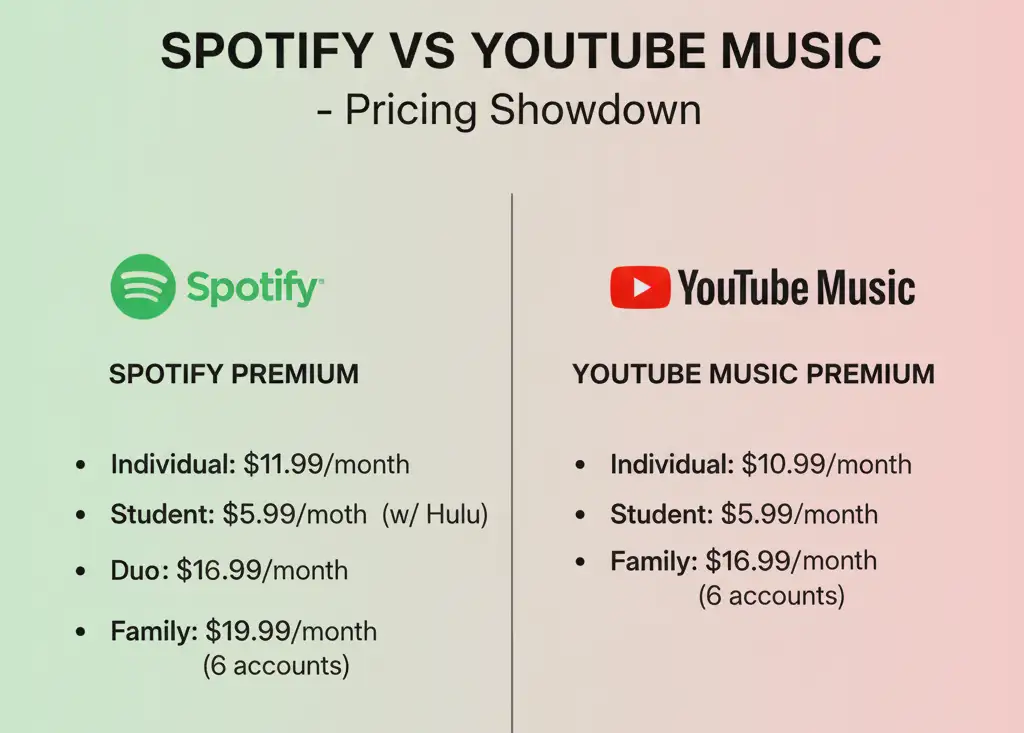
- Individual: $11.99/month
- Student: $5.99/month (includes Hulu access)
- Duo: $16.99/month
- Family: $19.99/month (up to 6 accounts)
- Individual: $10.99/month
- Student: $5.49/month
- Family: $16.99/month (up to 6 accounts)
YouTube Premium Bundle:
- Individual: $13.99/month (includes YouTube Music + ad-free YouTube)
- Family: $22.99/month
Value Proposition
When evaluating Spotify vs YouTube music prices, both platforms are competitive, but Spotify offers more value with additional services in its student plan. Spotify’s student plan includes access to Hulu, while YouTube Music’s slightly lower price point for families might appeal to budget-conscious households.
The YouTube Premium bundle presents compelling value for heavy YouTube users, as it combines ad-free YouTube viewing with YouTube Music at a relatively small premium over standalone music services.
Audio Quality and Streaming Performance
Technical Specifications
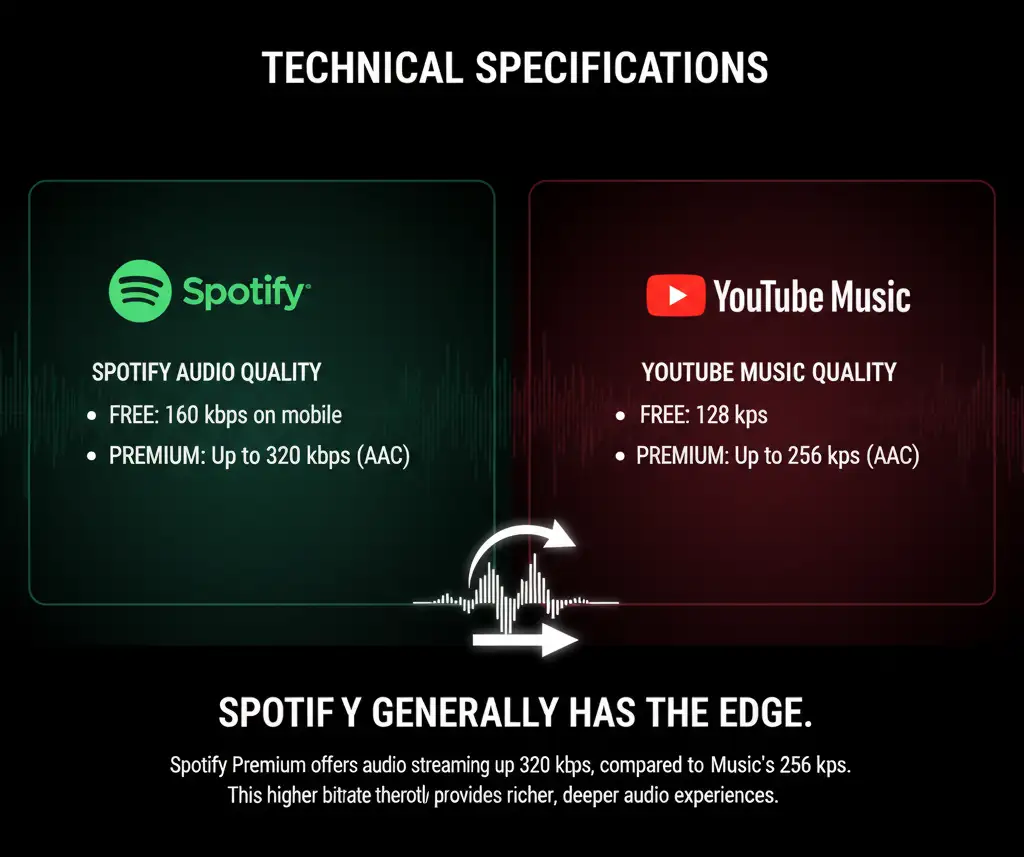
When it comes to Spotify vs YouTube music sound quality, Spotify generally has the edge. Spotify Premium offers audio streaming up to 320 kbps, compared to YouTube Music’s 256 kbps. This higher bitrate theoretically provides richer, deeper audio experiences, though the difference may not be noticeable to casual listeners.
Spotify Audio Quality:
- Free: 160 kbps on mobile
- Premium: Up to 320 kbps (AAC)
YouTube Music Audio Quality:
- Free: 128 kbps
- Premium: Up to 256 kbps (AAC)
Real-World Performance
While Spotify technically has a higher bitrate, you likely won’t be able to tell the difference unless you find a particularly bad upload of a song on YouTube Music. For most users with standard headphones or earbuds, both platforms deliver satisfactory audio quality for everyday listening.
User Interface and Experience
Spotify’s Design Philosophy
Spotify features a comprehensive interface with sections like Home, Search, Your Library, Premium, and Settings. It provides personalized playlists, new music releases, and easy navigation. The interface is intuitive and clean, making it easy for users to find what they’re looking for quickly.
The platform’s dark theme and card-based layout have become industry standards, offering excellent usability across all devices. Spotify’s social features, including collaborative playlists and friend activity feeds, enhance the community aspect of music discovery.
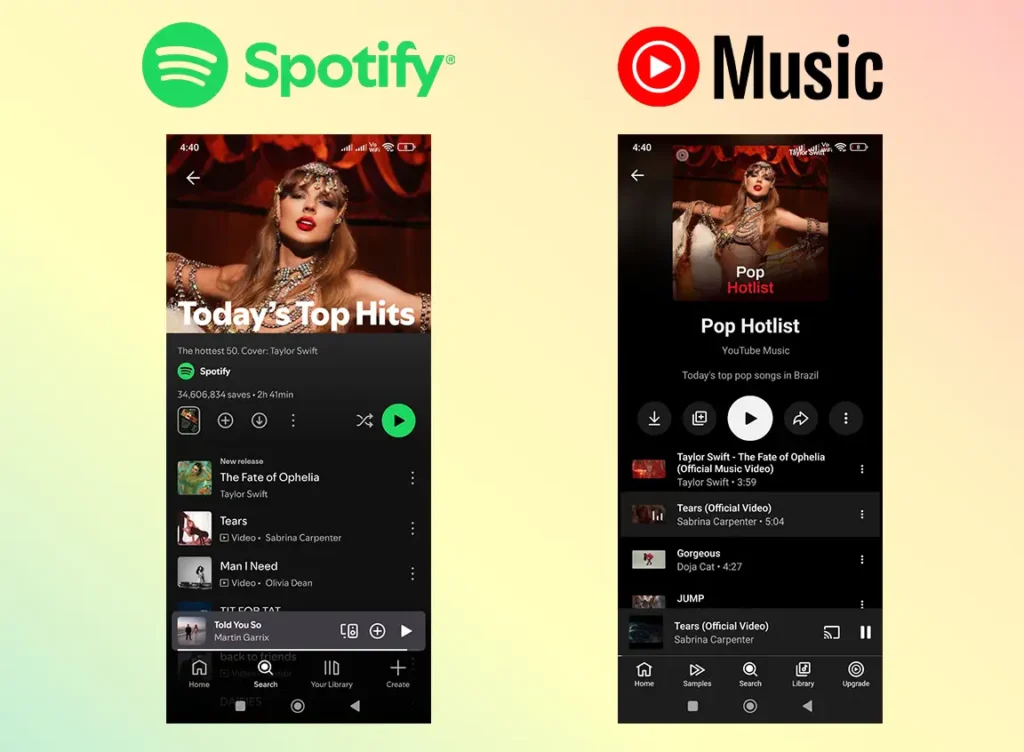
YouTube Music’s Approach
YouTube Music, on the other hand, centers its interface around a robust search bar, making it easy to find songs, albums, and artists. The interface draws heavily from YouTube’s design language, which may feel familiar to existing YouTube users but can seem cluttered to those accustomed to dedicated music apps.
YouTube Music’s unique advantage lies in its seamless switching between audio and video modes, allowing users to watch music videos or switch to audio-only playback within the same interface.
Music Discovery and Recommendations
Spotify’s Algorithm Advantage
People often choose Spotify for its user-friendly interface, strong social features (like collaborative playlists and friend activity feed), extensive podcast library, and well-curated playlists. Spotify’s music discovery algorithms are also highly regarded.
Spotify pioneered algorithmic music discovery with features like:
- Discover Weekly (personalized weekly playlist)
- Release Radar (new releases from followed artists)
- Daily Mix (genre-based daily playlists)
- AI DJ (conversational AI that curates music)
Spotify’s algorithm for music discovery is more sophisticated and effective than that of YouTube Music. The platform uses multiple algorithms to predict user preferences, resulting in highly accurate recommendations.
YouTube Music’s Discovery Features
YouTube Music offers several discovery features, though they’re generally considered less sophisticated than Spotify’s:
- Discover Mix (similar to Discover Weekly)
- My Super Mix (rotating top songs with new additions)
- New Release Mix (recent releases based on listening history)
Since YouTube Music is directly connected to your Google account, it pulls in data from all your Google services to make music recommendations. This integration can provide more context-aware suggestions based on your broader digital behavior.
Free Tier Comparison
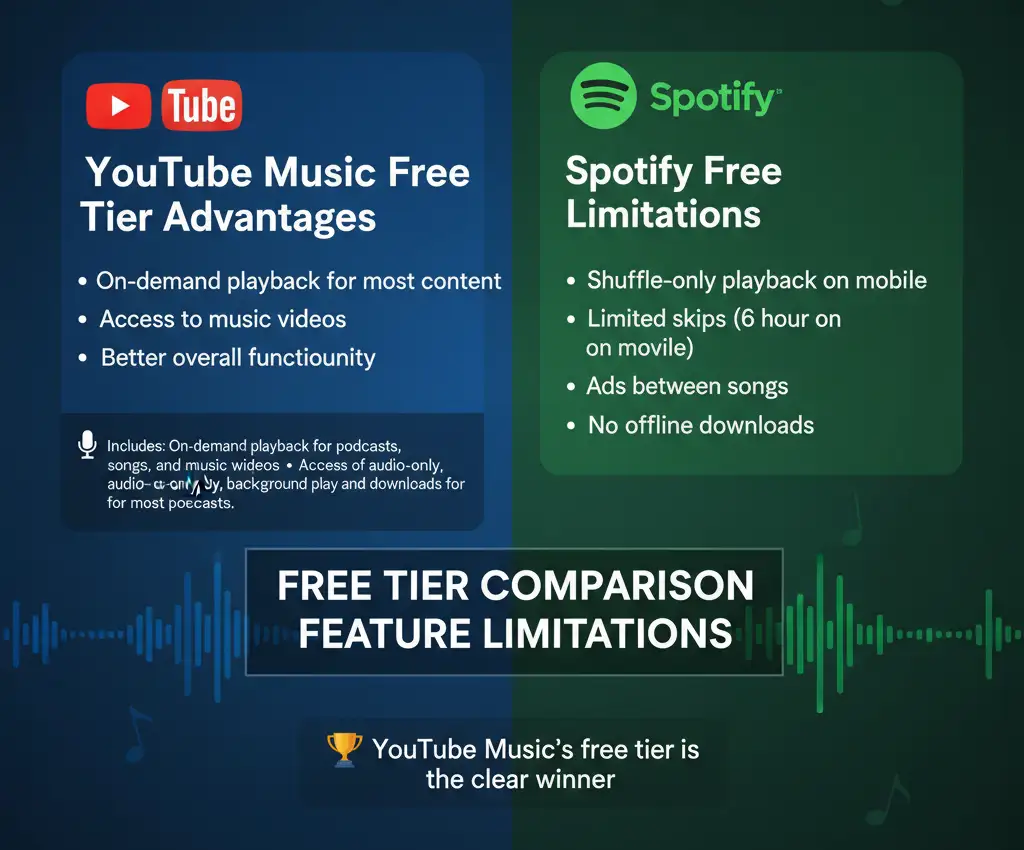
Feature Limitations
When it comes to features, YouTube Music’s free tier is the clear winner, as it includes: On-demand playback for podcasts, songs, and music videos · Access to audio-only, background play, and downloads for most podcasts.
Spotify Free Limitations:
- Shuffle-only playback on mobile
- Limited skips (6 per hour on mobile)
- Ads between songs
- No offline downloads
YouTube Music Free Advantages:
- On-demand playback for most content
- Access to music videos
- Better overall functionality compared to Spotify’s free tier
Audio Quality on Free Plans
Both services cap streaming quality: the free YouTube Music option tops out at 128kbps, and free Spotify maxes out at 160kbps on mobile. While Spotify offers slightly better audio quality on its free tier, YouTube Music’s superior feature set often outweighs this technical disadvantage.
Device Compatibility and Ecosystem Integration
Cross-Platform Availability
Both services offer comprehensive device support across smartphones, tablets, computers, smart speakers, and car systems. However, Spotify maintains a slight edge in terms of platform coverage and integration quality.
Spotify Connect stands out as a unique feature, allowing seamless device switching and multi-room audio control. You can use this feature to switch between devices, such as when you are listening to music on your phone but want to pause it on your laptop.
Smart Home Integration
Spotify generally offers broader smart home integration, supporting more voice assistants and smart speakers. YouTube Music benefits from Google’s ecosystem integration, working seamlessly with Google Home devices and Android Auto.
Podcast and Audio Content
Spotify’s Podcast Dominance
Spotify does have more podcasts than YouTube. The numbers suggest that Spotify has over 5 million podcasts. Spotify has invested heavily in podcast content, acquiring exclusive shows and creating original programming.
Spotify Podcast Features:
- Over 5 million podcast titles
- Exclusive content from major creators
- Integrated music and podcast experience
- Enhanced podcast discovery features
YouTube Music’s Video Podcast Advantage
But if you’re more of a video podcast kind, YouTube Premium is perfect. You can check out the entire show without ads & even scroll to certain time-stamped sections, all of which is unavailable on Spotify.
YouTube Music leverages YouTube’s video capabilities for podcast content, offering features that audio-only platforms cannot match, such as visual elements and chapter navigation.
Offline Features and Downloads
Download Capabilities
Both platforms offer offline download features for premium subscribers, but with different approaches:
Spotify Downloads:
- Manual selection of songs, albums, and playlists
- Up to 10,000 downloaded songs per device
- Automatic downloads for Discover Weekly and other algorithmic playlists
YouTube Music Downloads:
- Smart Downloads feature automatically downloads recommended content
- Manual download options available
- Offline mixtape feature for automatic content curation
YouTube Music’s Smart Downloads feature basically allows the app to download a set amount of songs (or a set amount of data) every day based on your listening habits. This automated approach can be particularly useful for users with inconsistent internet connectivity.
Social Features and Sharing
Spotify’s Social Ecosystem
Spotify leads in social music features with:
- Friend activity feed
- Collaborative playlists
- Music sharing to social platforms
- Group listening sessions (Premium only)
- Artist following and notifications
YouTube Music’s Social Integration
YouTube Music’s social features are more limited but include:
- Playlist sharing capabilities
- Integration with broader YouTube social features
- Community playlists discovery
- Artist channel following through YouTube
Regional Availability and Content
Both platforms are available in numerous countries worldwide, though content availability may vary by region due to licensing agreements. Spotify charges radically different rates from one country to another. Regional pricing variations can significantly impact the value proposition depending on your location.
Unique Features and Innovations
Spotify Exclusives
- Spotify Connect for seamless device switching
- AI DJ with conversational interface
- Car Thing (discontinued but shows innovation focus)
- Canvas (visual loops for songs)
- Enhanced playlist creation tools
YouTube Music Advantages
- Seamless audio/video switching
- Access to YouTube’s vast content library
- Music video integration
- Live performance availability
- User-generated content access
Performance and Reliability
Both platforms generally offer reliable streaming performance, though user experiences may vary based on internet connectivity and device capabilities. Spotify tends to have slightly more stable performance across different network conditions, while YouTube Music occasionally struggles with consistency due to its diverse content sources.
Customer Support and User Experience
Support Quality
Spotify offers comprehensive customer support through multiple channels, including email, chat, and community forums. The platform’s help documentation is extensive and regularly updated.
YouTube Music support is integrated with Google’s broader support ecosystem, which can be both an advantage (comprehensive resources) and disadvantage (less specialized music-focused support).
Future Outlook and Innovation
Spotify’s Direction
Spotify continues to invest heavily in:
- AI-powered personalization
- Podcast content and technology
- Social features and artist tools
- High-fidelity audio options
YouTube Music’s Evolution
YouTube Music benefits from Google’s broader technology investments:
- AI and machine learning improvements
- Integration with Google services
- Video content expansion
- Smart home ecosystem development
Making Your Choice: Which Platform Wins?
The choice between Spotify and YouTube Music ultimately depends on your specific needs and preferences:
Choose Spotify if you:
- Prioritize audio quality and music discovery
- Use podcasts extensively
- Value social music features
- Prefer a dedicated music-focused interface
- Want the most comprehensive device compatibility
Choose YouTube Music if you:
- Watch music videos regularly
- Want access to rare and live content
- Use YouTube Premium already
- Prefer a more affordable family plan
- Value Google ecosystem integration
Consider exploring new songs on both platforms during their free trial periods to determine which interface and recommendation system better suits your listening habits.
Frequently Asked Questions
Which service offers better value for money?
YouTube Music often provides better value, especially if you already use YouTube regularly. The YouTube Premium bundle includes ad-free YouTube viewing plus YouTube Music for just a few dollars more than standalone music services. However, Spotify’s student plan with Hulu inclusion offers exceptional value for eligible users.
Can I transfer my playlists between services?
While neither service offers official playlist transfer tools, third-party applications like SongShift, TuneMyMusic, and Soundiiz can help migrate playlists between platforms. The transfer success rate varies depending on song availability across services.
Which platform has better sound quality?
Spotify technically offers superior audio quality with 320 kbps streaming compared to YouTube Music’s 256 kbps maximum. However, for most listeners using standard audio equipment, the difference is negligible. YouTube Music’s integration with music videos can actually provide a richer multimedia experience.
Do both services work offline?
Yes, both platforms offer offline downloading for premium subscribers. Spotify allows manual selection of up to 10,000 songs per device, while YouTube Music includes Smart Downloads that automatically curate offline content based on your listening habits.
Which service is better for discovering new music?
Spotify generally excels in music discovery with more sophisticated algorithms and features like Discover Weekly, Release Radar, and AI DJ. YouTube Music’s discovery features are improving but currently lag behind Spotify’s recommendation accuracy and variety.
Are there any exclusive content differences?
Spotify focuses on exclusive podcast content and has invested heavily in original programming. YouTube Music’s strength lies in accessing YouTube’s vast library of live performances, covers, remixes, and user-generated content that isn’t available on traditional music platforms.

